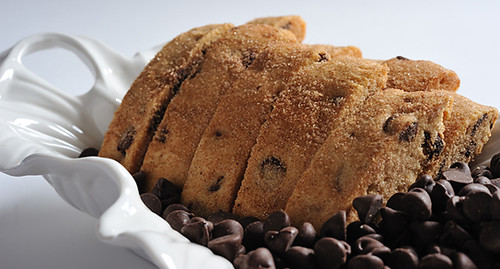What in the world is a twice-baked cookie?
To discover the real meaning of the twice-baked cookie, you've got to start with the biscuit. In terms of etymology, "biscuit" means "twice cooked"--and acording to John Ayto's book An A-Z of Food & Drink , "its name reflects the way in which it was once made. The originl biscuit was a small flat cake made of wheat flower, sugar, egg yolks, and perhaps a little yeast. It was intended for long keeping, so to dry it out it was returned to the oven for a while after the initial cooking process had finished". The signature hard texture and long shelf life has endeared the twice-baked cookie to seafaring voyagers, teething babies, and lends itself quite nicely to dunking in sweet wine.
, "its name reflects the way in which it was once made. The originl biscuit was a small flat cake made of wheat flower, sugar, egg yolks, and perhaps a little yeast. It was intended for long keeping, so to dry it out it was returned to the oven for a while after the initial cooking process had finished". The signature hard texture and long shelf life has endeared the twice-baked cookie to seafaring voyagers, teething babies, and lends itself quite nicely to dunking in sweet wine.
In the United States, the term "biscuit" refers to something else these days, but the concept of a twice-baked cookie is still very much alive. To Americans, the most famous example is probably the Italian version, biscotti. It's arguable, but our theory for its preeminence is that it grew in popularity with the coffee-house revolution that hit the US in a big way, in which biscotti was a common food to be offered.
Biscotti: While in Italy, biscotti is a kind of catch-all phrase for cookies, in North America, we think of it as a long, dry, hard twice-baked cookie with a curved top and flat bottom designed for dunking into wine or coffee. The name biscotti is derived from 'bis' meaning twice in Italian and 'cotto' meaning baked or cooked. Generally, what separates biscotti from other variations is that it frequently gets its fat solely from eggs and nuts--often it does not contain oil or butter. Of course, these days there are all sorts of variations, so this is not a hard-fast rule.
Here's a link to a delicious recipe.
Croquets de carcassonne (or biscotte): This is the french variation on biscotti; from what we could find, the major difference seems to be that biscotte contains butter (and plenty of it!). While we couldn't find the reasoning behind the name Croquets de carcassone, it did have a nice ring to it, so we included it! Here's a
recipe.

Mandelbrodt (also known as Mandelbread, Mondelbrodt, Mondel bread, and probably more that we've missed!): Never heard of it? No surprise. As our foodie crush Arthur Schwartz writes, "Isn't it ironic? It used to be that biscotti were explained as Italian mandelbread. These days, mandelbread is explained as Jewish biscotti." While mandelbrodt shares similarities to biscotti, it is not the same: unlike biscotti, which gets its fat primarily from eggs, mandelbrodt will generally contain oil as well. And while nuts are common in biscotti, they're a key ingredient in mandelbrodt, which literally translates to "almond bread". If you're curious, you can buy some via mail-order at marlasmandels.com (photo above); also, you can find a recipe here!

Paxemadia (or biskota): In this Greek version, from what we can gather, the main variation here is with spices--one informative biscotti recipe posting suggests that you could make a biscotti recipe into the Greek variation by adding "a flavor mixture of 1/4 cup flour mixed into 1 tablespoon crushed coriander seed, 1 tablespoon crushed anise seeds, 2 tablespoons grated orange peel, 2 tablespoons grated lemon peel; and 1 1/2 cups chopped toasted walnuts."
Rusks: Like the term "biscuit", "rusk" seems to be more of a concept, with all sorts of different cultural variations, from long, slender versions to small rounds to toast-shaped versions. Like Mandelbrodt, the rusk differs from biscotti in that it will often contain an added fat--oil, or sometimes butter. One thing seems certain though: more than any other variation, the Rusk seems to be attached to seafaring culture--Swedish recipe books and John Ayto's book (referenced above) both refer to it as a cookie that accompanied naval officers and sailors on long voyages. Here's a recipe.
Sukhariki: The Russian term also seems to be a catch-all, referring to any type of crispy bread, from more crouton-esque variations to sweetened ones. Here's a hazelnut variation.

Zwieback: Per Wikipedia, the name comes from German zwei, meaning "two", and backen, meaning "to bake". This is the only variation in which we saw recipes that called for yeast, and indeed, this would be in keeping with it sometimes being referred to as "zwieback toast". Of course, this is not to be confused with Russian Mennonite Zwieback, which is more like a roll. More than any other variation, we associate this one as a baby's toothing snack. Most notably, however, we have to say, zwieback certainly takes the cake when it comes to cultural references. here are just a few:
 Monday, February 23, 2009
Monday, February 23, 2009 


 Cookies,
Cookies,  cakespy undercover,
cakespy undercover,  seattle
seattle 





























































